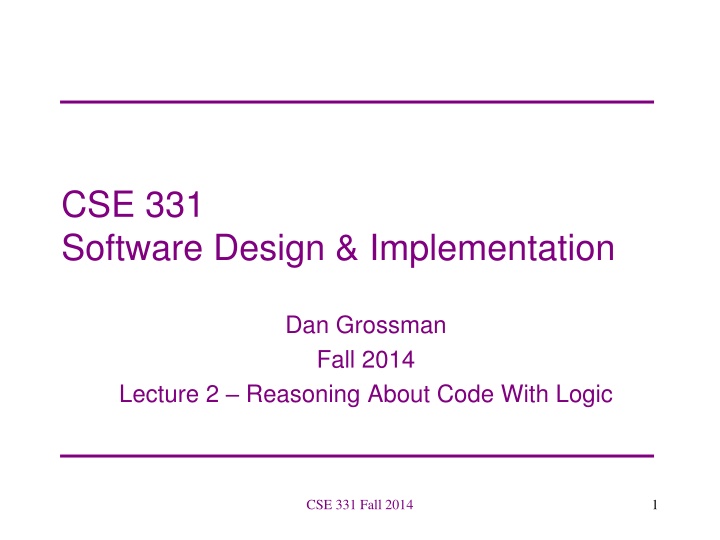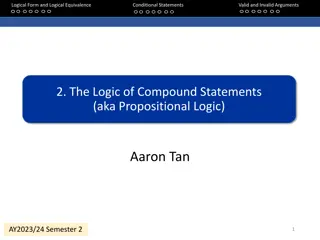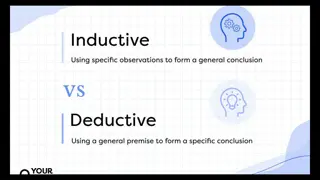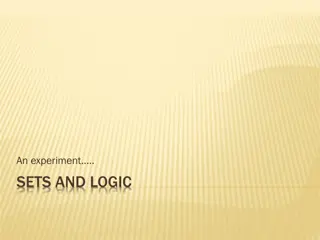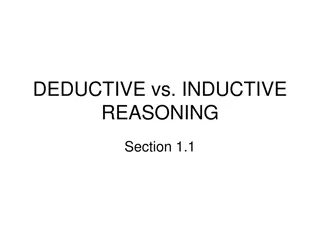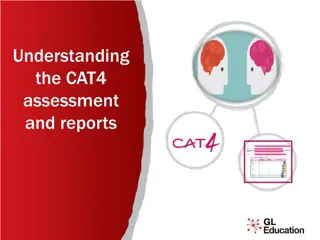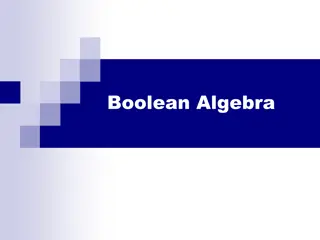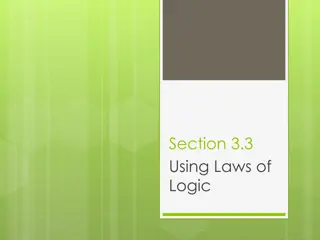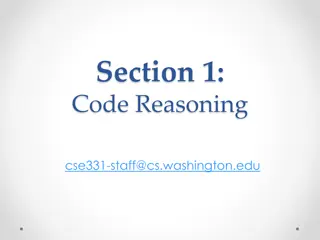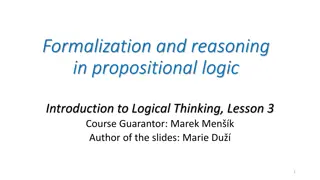Logical Reasoning in Software Design and Implementation
Logical reasoning in software development involves determining the truth of facts as a program runs under specific assumptions. This process complements testing by allowing programmers to reason about classes of inputs/states and verify program correctness. Hoare Logic is introduced as a method for logical reasoning about code variables, assignments, and control structures like if-statements and while-loops. While programmers may not frequently use this level of logic, it proves useful for verifying loops with complex invariants and establishing precise specifications for library interfaces.
Download Presentation

Please find below an Image/Link to download the presentation.
The content on the website is provided AS IS for your information and personal use only. It may not be sold, licensed, or shared on other websites without obtaining consent from the author.If you encounter any issues during the download, it is possible that the publisher has removed the file from their server.
You are allowed to download the files provided on this website for personal or commercial use, subject to the condition that they are used lawfully. All files are the property of their respective owners.
The content on the website is provided AS IS for your information and personal use only. It may not be sold, licensed, or shared on other websites without obtaining consent from the author.
E N D
Presentation Transcript
CSE 331 Software Design & Implementation Dan Grossman Fall 2014 Lecture 2 Reasoning About Code With Logic CSE 331 Fall 2014 1
Reasoning about code Determine what facts are true as a program executes Under what assumptions Examples: If x starts positive, then y is 0 when the loop finishes Contents of the array arr refers to are sorted Except at one code point, x + y == z For all instances of Node n, n.next == null n.next.prev == n CSE 331 Fall 2014 2
Why do this? Essential complement to testing, which we will also study Testing: Actual results for some actual inputs Logical reasoning: Reason about whole classes of inputs/states at once ( If x > 0, ) Prove a program correct (or find bugs trying) Understand why code is correct Stating assumptions is the essence of specification Callers must not pass null as an argument Callee will always return an unaliased object CSE 331 Fall 2014 3
Our approach Hoare Logic: a 1970s approach to logical reasoning about code For now, consider just variables, assignments, if-statements, while-loops So no objects or methods This lecture: The idea, without loops, in 3 passes 1. High-level intuition of forward and backward reasoning 2. Precise definition of logical assertions, preconditions, etc. 3. Definition of weaker/stronger and weakest-precondition Next lecture: Loops CSE 331 Fall 2014 4
Why? Programmers rarely use Hoare logic like in this lecture For simple snippets of code, it s overkill Gets very complicated with objects and aliasing But is occasionally useful for loops with subtle invariants Examples: Homework 0, Homework 2 Also it s an ideal setting for the right logical foundations How can logic talk about program states? How does code execution change what is true ? What do weaker and stronger mean? This is all essential for specifying library-interfaces, which does happen All the Time in The Real World (coming lectures) CSE 331 Fall 2014 5
Example Forward reasoning: Suppose we initially know (or assume) w > 0 // w > 0 x = 17; // w > 0 x == 17 y = 42; // w > 0 x == 17 y == 42 z = w + x + y; // w > 0 x == 17 y == 42 z > 59 Then we know various things after, including z > 59 CSE 331 Fall 2014 6
Example Backward reasoning: Suppose we want z to be negative at the end // w + 17 + 42 < 0 x = 17; // w + x + 42 < 0 y = 42; // w + x + y < 0 z = w + x + y; // z < 0 Then we know initially we need to know/assume w < -59 Necessary and sufficient CSE 331 Fall 2014 7
Forward vs. Backward, Part 1 Forward reasoning: Determine what follows from initial assumptions Most useful for maintaining an invariant Backward reasoning Determine sufficient conditions for a certain result If result desired, the assumptions suffice for correctness If result undesired, the assumptions suffice to trigger bug CSE 331 Fall 2014 8
Forward vs. Backward, Part 2 Forward reasoning: Simulates the code (for many inputs at once ) Often more intuitive But introduces [many] facts irrelevant to a goal Backward reasoning Often more useful: Understand what each part of the code contributes toward the goal Thinking backwards takes practice but gives you a powerful new way to reason about programs CSE 331 Fall 2014 9
Conditionals // initial assumptions if( ) { // also know test evaluated to true } else { // also know test evaluated to false } // either branch could have executed Two key ideas: 1. The precondition for each branch includes information about the result of the test-expression 2. The overall postcondition is the disjunction ( or ) of the postcondition of the branches CSE 331 Fall 2014 10
Example (Forward) Assume initially x >= 0 // x >= 0 z = 0; // x >= 0 z == 0 if(x != 0) { // x >= 0 z == 0 x != 0 (so x > 0) z = x; // z > 0 } else { // x >= 0 z == 0 !(x!=0) (so x == 0) z = x + 1; // z == 1 } // ( z > 0) ( z == 1) (so z > 0) CSE 331 Fall 2014 11
Our approach Hoare Logic, a 1970s approach to logical reasoning about code [Named after its inventor, Tony Hoare] Considering just variables, assignments, if-statements, while-loops So no objects or methods This lecture: The idea, without loops, in 3 passes 1. High-level intuition of forward and backward reasoning 2. Precise definition of logical assertions, preconditions, etc. 3. Definition of weaker/stronger and weakest-precondition Next lecture: Loops CSE 331 Fall 2014 12
Some notation and terminology The assumption before some code is the precondition The what holds after (given assumption) is the postcondition Instead of writing pre/postconditions after //, write them in { } This is not Java How Hoare logic has been written on paper for 40ish years { w < -59 } x = 17; { w + x < -42 } In pre/postconditions, = is equality, not assignment Math s = , which for numbers is Java s == { w > 0 x = 17 } y = 42; { w > 0 x = 17 y = 42 } CSE 331 Fall 2014 13
What an assertion means An assertion (pre/postcondition) is a logical formula that can refer to program state (e.g., contents of variables) A program stateis something that given a variable can tell you its contents Or any expression that has no side-effects An assertion holds for a program state, if evaluating using the program state produces true Evaluating a program variable produces its contents in the state Can think of an assertion as representing the set of (exactly the) states for which it holds CSE 331 Fall 2014 14
A Hoare Triple A Hoare triple is two assertions and one piece of code: {P} S {Q} P the precondition S the code (statement) Q the postcondition A Hoare triple {P} S {Q} is (by definition) valid if: For all states for which P holds, executing S always produces a state for which Q holds Less formally: If P is true before S, then Q must be true after Else the Hoare triple is invalid CSE 331 Fall 2014 15
Examples Valid or invalid? (Assume all variables are integers without overflow) {x != 0} y = x*x; {y > 0} {z != 1} y = z*z; {y != z} {x >= 0} y = 2*x; {y > x} {true} (if(x > 7) {y=4;} else {y=3;}) {y < 5} {true} (x = y; z = x;) {y=z} {x=7 y=5} (tmp=x; x=tmp; y=x;) {y=7 x=5} CSE 331 Fall 2014 16
Examples Valid or invalid? (Assume all variables are integers without overflow) {x != 0} y = x*x; {y > 0} valid {z != 1} y = z*z; {y != z} invalid {x >= 0} y = 2*x; {y > x} invalid {true} (if(x > 7) {y=4;} else {y=3;}) {y < 5} valid {true} (x = y; z = x;) {y=z} valid {x=7 y=5} invalid (tmp=x; x=tmp; y=x;) {y=7 x=5} CSE 331 Fall 2014 17
Aside: assert in Java An assertion in Java is a statement with a Java expression, e.g., assert x > 0 && y < x; Similar to our assertions Evaluate using a program state to get true or false Uses Java syntax In Java, this is a run-time thing: Run the code and raise an exception if assertion is violated Unless assertion-checking is disabled Later course topic This week: we are reasoning about the code, not running it on some input CSE 331 Fall 2014 18
The general rules So far: Decided if a Hoare triple was valid by using our understanding of programming constructs Now: For each kind of construct there is a general rule A rule for assignment statements A rule for two statements in sequence A rule for conditionals [next lecture:] A rule for loops CSE 331 Fall 2014 19
Assignment statements {P} x = e; {Q} Let Q be like Q except replace every x with e Triple is valid if: For all program states, if P holds, then Q holds That is, P implies Q , written P => Q Example: {z > 34} y=z+1; {y > 1} Q is {z+1 > 1} CSE 331 Fall 2014 20
Sequences {P} S1;S2 {Q} Triple is valid if and only if there is an assertion R such that {P}S1{R} is valid, and {R}S2{Q} is valid Example: {z >= 1} y=z+1; w=y*y; {w > y} (integers) Let R be {y > 1} Show {z >= 1} y=z+1; {y > 1} Use rule for assignments: z >= 1 implies z+1 > 1 Show {y > 1} w=y*y; {w > y} Use rule for assignments: y > 1 implies y*y > y CSE 331 Fall 2014 21
Conditionals {P} if(b) S1 else S2 {Q} Triple is valid if and only if there are assertions Q1,Q2 such that {P b}S1{Q1} is valid, and {P !b}S2{Q2} is valid, and Q1 Q2 implies Q Example: {true} (if(x > 7) y=x; else y=20;) {y > 5} Let Q1 be {y > 7} (other choices work too) Let Q2 be {y = 20} (other choices work too) Use assignment rule to show {true x > 7}y=x;{y>7} Use assignment rule to show {true x <= 7}y=20;{y=20} Indicate y>7 y=20 implies y>5 CSE 331 Fall 2014 22
Our approach Hoare Logic, a 1970s approach to logical reasoning about code Considering just variables, assignments, if-statements, while-loops So no objects or methods This lecture: The idea, without loops, in 3 passes 1. High-level intuition of forward and backward reasoning 2. Precise definition of logical assertions, preconditions, etc. 3. Definition of weaker/stronger and weakest-precondition Next lecture: Loops CSE 331 Fall 2014 23
Weaker vs. Stronger If P1 implies P2 (written P1 => P2), then: P1 is stronger than P2 P2 is weaker than P1 Whenever P1 holds, P2 also holds So it is more (or at least as) difficult to satisfy P1 The program states where P1 holds are a subset of the program states where P2 holds So P1 puts more constraints on program states So it s a stronger set of obligations/requirements CSE 331 Fall 2014 24
Examples x = 17 is stronger than x > 0 x is prime is neither stronger nor weaker than x is odd x is prime and x > 2 is stronger than x is odd and x > 2 CSE 331 Fall 2014 25
Why this matters to us Suppose: {P}S{Q}, and P is weaker than some P1, and Q is stronger than some Q1 Then: {P1}S{Q} and {P}S{Q1} and {P1}S{Q1} Example: P is x >= 0 P1 is x > 0 S is y = x+1 Q is y > 0 Q1 is y >= 0 CSE 331 Fall 2014 26
So For backward reasoning, if we want {P}S{Q}, we could instead: Show {P1}S{Q}, and Show P => P1 Better, we could just show {P2}S{Q} where P2 is the weakest precondition of Q for S Weakest means the most lenient assumptions such that Q will hold Any precondition P such that {P}S{Q} is valid will be stronger than P2, i.e., P => P2 Amazing (?): Without loops/methods, for any S and Q, there exists a unique weakest precondition, written wp(S,Q) Like our general rules with backward reasoning CSE 331 Fall 2014 27
Weakest preconditions wp(x = e;, Q) is Q with each x replaced by e Example: wp(x = y*y;, x > 4) = y*y > 4, i.e., |y| > 2 wp(S1;S2, Q) is wp(S1,wp(S2,Q)) I.e., let R be wp(S2,Q) and overall wp is wp(S1,R) Example: wp((y=x+1; z=y+1;), z > 2) = (x + 1)+1 > 2, i.e., x > 0 wp(if b S1 else S2, Q) is this logic formula: (b wp(S1,Q)) (!b wp(S2,Q)) (In any state, b will evaluate to either true or false ) (You can sometimes then simplify the result) CSE 331 Fall 2014 28
Simple examples If S is x = y*y and Q is x > 4, then wp(S,Q) is y*y > 4, i.e., |y| > 2 If S is y = x + 1; z = y 3; and Q is z = 10, then wp(S,Q) = wp(y = x + 1; z = y 3;, z = 10) = wp(y = x + 1;,wp(z = y 3;, z = 10)) = wp(y = x + 1;, y-3 = 10) = wp(y = x + 1;, y = 13) = x+1 = 13 = x = 12 CSE 331 Fall 2014 29
Bigger example S is if (x < 5) { x = x*x; } else { x = x+1; } Q is x >= 9 wp(S, x >= 9) = (x < 5 wp(x = x*x;, x >= 9)) (x >= 5 wp(x = x+1;, x >= 9)) = (x < 5 x*x >= 9) (x >= 5 x+1 >= 9) = (x <= -3) (x >= 3 x < 5) (x >= 8) -4-3-2-1 0 1 2 3 4 5 6 7 8 9 CSE 331 Fall 2014 30
If-statements review Forward reasoning Backward reasoning {P} if B {P B} S1 {Q1} else {P !B} S2 {Q2} {Q1 Q2} { (B wp(S1, Q)) (!B wp(S2, Q)) } if B {wp(S1, Q)} S1 {Q} else {wp(S2, Q)} S2 {Q} {Q} CSE 331 Fall 2014 31
Correct If wp(S,Q) is true, then executing S will always produce a state where Q holds true holds for every program state CSE 331 Fall 2014 32
One more issue With forward reasoning, there is a problem with assignment: Changing a variable can affect other assumptions Example: {true} w=x+y; {w = x + y;} x=4; {w = x + y x = 4} y=3; {w = x + y x = 4 y = 3} But clearly we do not know w=7! CSE 331 Fall 2014 33
The fix When you assign to a variable, you need to replace all other uses of the variable in the post-condition with a different variable So you refer to the old contents Corrected example: {true} w=x+y; {w = x + y;} x=4; {w = x1 + y x = 4} y=3; {w = x1 + y1 x = 4 y = 3} CSE 331 Fall 2014 34
Useful example Swap contents Give a name to initial contents so we can refer to them in the post-condition Just in the formulas: these names are not in the program Use these extra variables to avoid forgetting connections {x = x_pre y = y_pre} tmp = x; {x = x_pre y = y_pre tmp=x} x = y; {x = y y = y_pre tmp=x_pre} y = tmp; {x = y_pre y = tmp tmp=x_pre} CSE 331 Fall 2014 35
